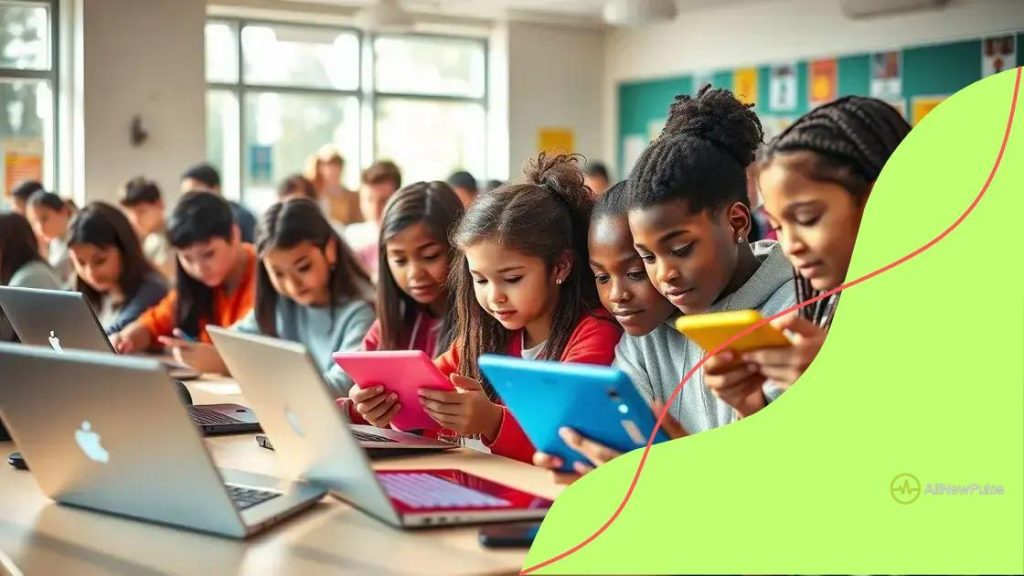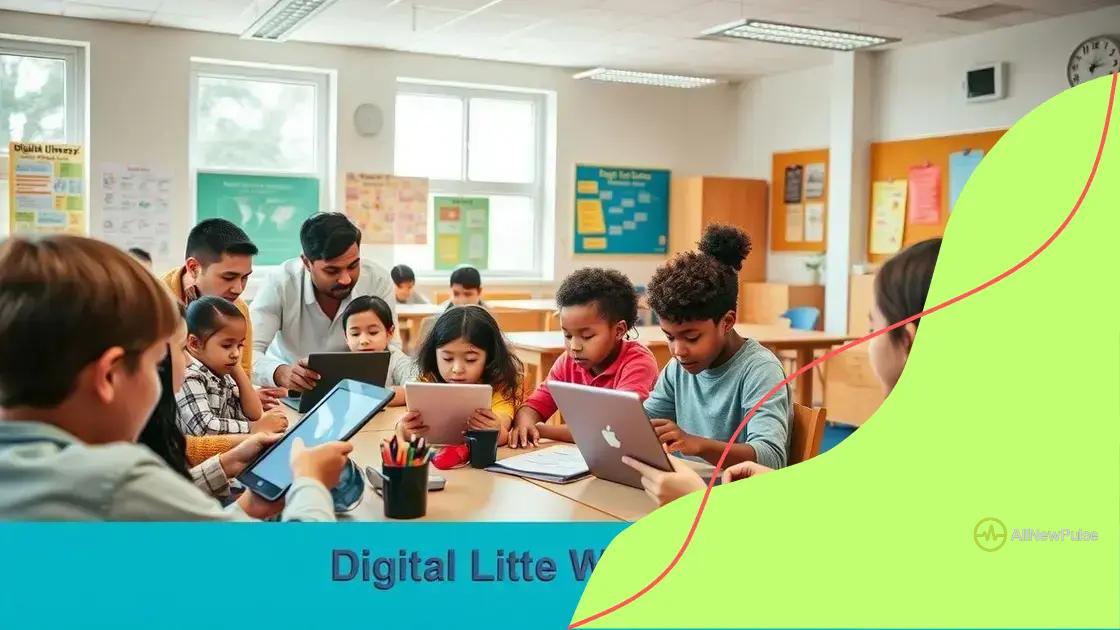Addressing the digital divide in schools: a step forward

Addressing the digital divide in schools involves providing access to technology and the internet, ensuring digital literacy, and fostering community partnerships to create equitable educational opportunities for all students.
Addressing the digital divide in schools is more important than ever. Have you ever wondered how technology impacts learning? In today’s world, ensuring every student has access to digital tools can change outcomes dramatically.
Understanding the digital divide in education
Understanding the digital divide in education is essential for creating equitable learning environments. This gap affects students’ access to technology and the internet, which are crucial for modern education. Without adequate access, many students miss out on important resources and opportunities.
What is the digital divide?
The digital divide refers to the disparity between those who have access to digital technology and those who do not. This includes access to computers, high-speed internet, and even digital literacy skills.
Key factors contributing to the digital divide
- Socioeconomic status: Students from low-income families often lack access to technology at home.
- Geographic location: Rural areas may have limited internet service compared to urban centers.
- School funding: Schools in wealthier districts can invest more in technology compared to those in underfunded areas.
- Digital literacy: Not all students have the skills needed to use technology effectively.
These factors combine to create a significant barrier for many students. In the classroom, technology can enhance learning and engagement, but not all students can take part equally.
For example, students who can access online resources can complete assignments and participate in virtual discussions while others might rely on outdated textbooks. This discrepancy emphasizes the importance of addressing the digital divide to ensure that every student has the tools they need to succeed.
Impact on education
The lack of access leads to unequal educational outcomes. Students with limited connectivity may struggle to keep up with their peers, which can affect overall academic performance. Additionally, teachers may face challenges in effectively incorporating technology into their lessons when students cannot participate fully.
To combat these issues, schools and communities are working to find solutions that can bridge the divide. Initiatives that provide devices, improve broadband access, and enhance digital literacy training are crucial in this fight for equity.
Key factors contributing to the digital divide
Recognizing the key factors contributing to the digital divide is essential for addressing this pressing issue. Various elements play a role in creating gaps in technology access among students. Understanding these factors helps identify effective solutions to bridge the divide.
Socioeconomic status
One of the largest contributors to the digital divide is socioeconomic status. Families with lower income often cannot afford devices or internet access. This lack of resources can significantly hinder a student’s ability to learn and engage with digital content.
Geographic location
Another critical factor is geographic location. Students living in rural areas frequently encounter limited internet availability compared to those in urban settings. This disparity can leave many students without reliable access to necessary online resources.
School funding
School funding also plays a vital role in determining how well students can access technology. Schools in wealthier districts often have better access to technology. In contrast, schools in lower-income areas struggle to provide adequate resources for their students.
Digital literacy skills
Furthermore, digital literacy is a crucial aspect of the divide. Not all students possess the skills needed to navigate technology effectively. This lack of skills can prevent students from fully utilizing available resources, regardless of access.
Working to understand these factors is the first step toward creating solutions that provide equitable access to technology. Community programs, school initiatives, and government policies can help reduce the impact of these issues.
Strategies for bridging the gap in schools

Implementing effective strategies for bridging the gap in schools is essential for closing the digital divide. Various methods can enhance access to technology and resources for all students. When schools take the initiative to adopt these strategies, they create a more equitable learning environment.
Providing devices to students
One strategy is to provide devices, like laptops or tablets, to students who lack access at home. This ensures that every student can engage with digital content, complete assignments, and practice essential skills.
Expanding internet access
Additionally, expanding internet access is crucial. Schools can partner with local businesses or governments to improve broadband connectivity in underserved areas. Offering Wi-Fi hotspots for students can also help bridge this gap.
Offering training programs
- Digital literacy training: Schools should offer programs that teach students how to use technology effectively.
- Workshops for parents: Educating parents about technology can help them support their children’s learning at home.
- Professional development for teachers: Teachers need ongoing training to integrate technology into their lessons.
Implementing these programs not only supports student learning but also encourages families to engage with technology.
Creating community partnerships can also be beneficial. Schools can collaborate with local organizations to provide resources and support to families, ensuring students have what they need to succeed.
Finally, actively seeking feedback from students and parents can help schools refine their strategies and address any ongoing challenges.
The role of technology in modern education
The role of technology in modern education has become increasingly important. As classrooms evolve, technology supports teaching and learning in innovative ways. By integrating digital tools, educators can enhance student engagement and improve learning outcomes.
Interactive learning environments
Technology creates interactive learning environments that draw students in. For example, using smartboards and projectors allows teachers to present lessons dynamically. These tools make it easy to incorporate multimedia elements, like videos and animations, that can capture students’ attention.
Access to resources
Students now have access to a vast array of resources online. This includes e-books, online courses, and educational apps that can deepen understanding. When students can access materials outside of the traditional textbook, their opportunities for learning increase.
Collaboration and communication
Technology also enhances collaboration among students. Through tools like Google Classroom and Microsoft Teams, students can work together on projects, share ideas, and receive feedback from peers and teachers. This fosters a sense of community and teamwork, even in virtual settings.
Personalized learning
Another significant advantage of technology in education is the ability to personalize learning experiences. Platforms can adapt to individual learning paces and styles. This personalization ensures that all students, regardless of their background, can thrive.
Furthermore, data analytics allow teachers to track student progress effectively. By analyzing data, educators can identify areas where students struggle and adjust their teaching methods accordingly.
Overall, the integration of technology in education transforms how students learn and interact with content. It empowers educators to provide rich, diverse, and effective learning experiences.
Case studies on successful digital inclusion initiatives
Examining case studies on successful digital inclusion initiatives provides valuable insights into effective strategies for bridging the digital divide in education. These real-world examples demonstrate how communities and schools can implement solutions that promote technology access and enhance learning.
1. Project Access in San Francisco
Project Access is an initiative in San Francisco aimed at providing students in low-income areas with computers and internet access. By partnering with local businesses and nonprofits, the program offers refurbished devices to families and supports students with digital literacy training. This initiative has increased school attendance and engagement.
2. Chicago Connected
Chicago Connected focuses on connecting students from underserved communities to high-speed internet. The city collaborates with internet service providers to ensure affordable access for families. This initiative has led to over 100,000 students gaining reliable internet, which has improved academic performance during remote learning periods.
3. The Digital Promise League of Innovative Schools
This program brings together schools across the country that are committed to advancing technology use in education. Schools in this initiative share best practices and resources to improve digital literacy and access. Participating schools have reported enhanced student engagement and academic achievement.
4. ConnectHome USA
ConnectHome USA works to bridge the digital divide specifically for public housing residents. By providing free or low-cost internet access and digital training, the program ensures that families can engage in online learning. Cities participating in this initiative have witnessed an increase in digital skills among parents and students alike.
These case studies highlight that successful digital inclusion initiatives require collaboration, community involvement, and targeted resources. Implementing such programs can lead to lasting positive changes in education and help close the digital divide.
In summary, addressing the digital divide in education is crucial for creating equal opportunities for all students. By understanding the key factors contributing to this issue and implementing effective strategies, schools can promote digital inclusion. Successful initiatives show that collaboration, innovation, and community support can make a significant difference. As we continue to embrace technology in education, we must ensure that every student has access to the tools they need to succeed.
FAQ – Questions About Addressing the Digital Divide in Schools
What is the digital divide in education?
The digital divide refers to the gap between those who have access to technology and the internet and those who do not, impacting educational opportunities.
How can schools bridge the digital divide?
Schools can bridge the divide by providing devices, expanding internet access, offering digital literacy training, and collaborating with community organizations.
What role do community partnerships play?
Community partnerships enable schools to access additional resources and support, ensuring that every student has the tools needed for academic success.
Why is digital literacy important?
Digital literacy is crucial as it equips students with the necessary skills to navigate technology effectively, enhancing their learning experiences.





